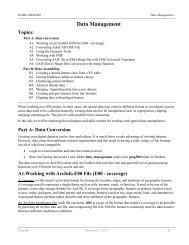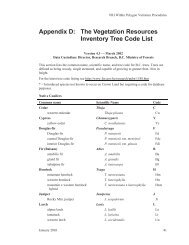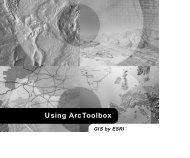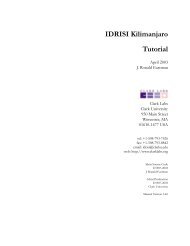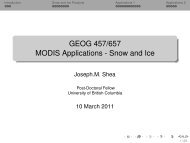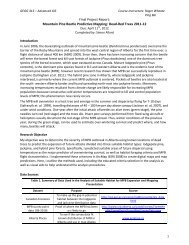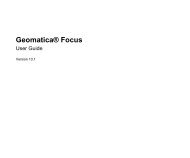Understanding Map Projections
Understanding Map Projections
Understanding Map Projections
Create successful ePaper yourself
Turn your PDF publications into a flip-book with our unique Google optimized e-Paper software.
CRASTER PARABOLIC<br />
Distance<br />
Scale is true along latitudes 36°46' N and S. Scale is<br />
also constant along any given latitude and is<br />
symmetrical around the equator.<br />
LIMITATIONS<br />
Useful only as a world map.<br />
USES AND APPLICATIONS<br />
Thematic world maps.<br />
The central meridian is 0°.<br />
DESCRIPTION<br />
This pseudocylindrical equal area projection is<br />
primarily used for thematic maps of the world. Also<br />
known as Putnins P4.<br />
PROJECTION METHOD<br />
Pseudocylindrical.<br />
LINEAR GRATICULES<br />
The central meridian is a straight line half as long as<br />
the equator. Parallels are unequally spaced, straight<br />
parallel lines perpendicular to the central meridian.<br />
Their spacing decreases very gradually as they move<br />
away from the equator.<br />
PROPERTIES<br />
Shape<br />
Free of distortion at the central meridian at 36°46' N<br />
and S. Distortion increases with distance from these<br />
points and is most severe at the outer meridians and<br />
high latitudes. Interrupting the projection greatly<br />
reduces this distortion.<br />
Area<br />
Equal area.<br />
Direction<br />
Local angles are correct at the intersection of<br />
36°46' N and S with the central meridian. Direction is<br />
distorted elsewhere.<br />
44 • <strong>Understanding</strong> <strong>Map</strong> <strong>Projections</strong>




